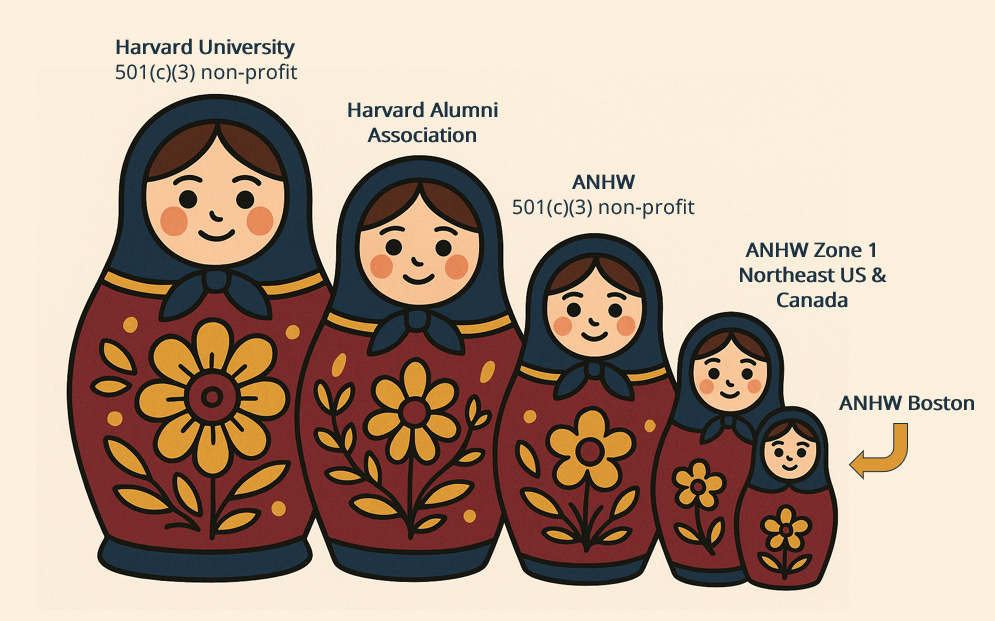Demystifying Programs, Projects, and Products in Non-Profits
Because sometimes you don't even know you're running a program...
I’ve run a non-profit program called the Boston Chapter for the Alumnae-i Network for Harvard Women (ANHW Boston) for a long time now. Despite being an experienced program management professional, it took me an embarrassing amount of time to fully understand that I was running a program. Why did this reveal take so long?
The word “Program” is nowhere in the title.
My title was President, not program manager.
I oversaw a Steering Committee, not project managers.
We were all volunteers.
The upfront markers were missing, but my brain began to organize our work into a program nonetheless. Our events and communications became the projects. We started developing repeatable processes that differentiated our events, which began to resemble products. Through repetition and relationship building, we began to grow, creating larger and more purposeful events.
The biggest win is that when I fully restructured my thinking from a volunteer group to a program, the gates opened: leadership, decision-making, and even commitment became easier, and the organization more successful.
Embracing a program management framework
Often in non-profits, we don’t think of our work in such strict terms of program, project, and product. Maybe we are “just” volunteering, or our job title doesn’t include “program” in the title. Perhaps you are a program manager, but that’s simply the title Human Resources assigned to you. The words don’t mean that much. Further, you are focused on the mission, whether it be producing musical theatre in your community or operating a high-end simulation training unit for a major hospital. Applying a highly structured framework to your work and starting to label activities projects, programs, and products may feel antithetical to the creative process.
In contrast to detracting from the spirit of a mission-based operation, applying a high-quality program management framework to your efforts unlocks long-term potential. It can facilitate easier organization and communication of your work, better decision making, and fairer hiring and promotional practices across your team. Over time, your work will become more focused, allowing you to achieve greater results.
But before getting too far ahead of ourselves, what are the ingredients of a non-profit program? Are you actually in one? I’ll use ANHW Boston as a case study.
The Definitions
The best reference for program management fundamentals is the Project Management Institute (PMI). Here is PMI’s definitions (1 p. 4) for three key words to get to know by heart:
Program: Related projects, subsidiary programs, and program activities that are managed in a coordinated manner to obtain benefits not available from managing them individually.
Project: A temporary endeavor undertaken to create a unique product, service, or result. The temporary nature of projects indicates a beginning and an end to the project work or a phase of the project work. Projects can stand alone or be part of a program or portfolio.
Product: An artifact that is produced, is quantifiable, and can be either an end item in itself or a component item.
All are technically accurate definitions, but are admittedly hard to grasp when trying to understand your work’s underlying heartbeat. Here are more characteristics of a non-profit program.
Four Traits of a Non-Profit Program
1. A program is part of a larger organization
ANHW Boston, like many programs, is its own little unit within the many layers of the organizational hierarchy. In my case, ANHW Boston is unique in that our group operates within a non-profit organization, which in turn is closely associated with another non-profit organization, Harvard University. We are a nesting doll of non-profits.
To be a program, you need to be a part of a larger entity. Often, a layer or two down the chain of a non-profit’s top leadership.
Essentially, the only restriction is that you can’t be your own independent business. Admittedly, there’s significant overlap in the skill sets required for a program management professional and a small business owner, but your overarching organizational structure is quite different.
Additionally, for new or smaller non-profits, the program may be nearly the entire business’s service offering, but it is still not the equivalent of the accounting, HR, etc., needed for a company. A program must exist within a larger organization.
2. A program has an independent goal
Despite many layers of oversight, ANHW Boston has its own focus – advancing women’s equity and leadership through alumnae-i connections in Greater Boston – and operates relatively independently in terms of decision-making around events and activities.
It may seem obvious, but to be a program, one must have an aligned yet distinct purpose from the larger business. The team running the entire non-profit, ANHW International, is responsible for worldwide events, as well as supporting the underlying structure for the individual chapters and smaller discussion and social groups worldwide. I’m uniquely responsible for creating events and communications that advance women’s equity and leadership directly in Greater Boston. ANHW International and ANHW Boston are together, yet independent.
3. A program can’t be a project
Another source of confusion within non-profits is the definition of what constitutes a project versus a program. These terms are often used interchangeably and haphazardly.
For example, during my previous employment at Boston Children’s Hospital, I observed that the titles of project and program managers were used seemingly interchangeably across the organization. I also recalled reading the standardized job descriptions and not being able to internalize a substantive underlying difference. At this non-profit organization in the mid-to-late 2010s, there was no clear distinction between the project and program workforces.
Program management literature (2 p.37) centers the distinction between projects and programs on two major themes. First, projects create a deliverable, whereas programs create benefits. Furthermore, projects are time-bound, whereas programs are ongoing in nature.
My sniff test for determining whether a body of work is a project or program is to examine its goal. If your goal is “ethereal” (save starving children), it’s a program. If your goal is to make something (build a food pantry), it’s a project.
ANHW Boston’s ethereal goal is to improve women’s equity and leadership through alumnae-i connection in Greater Boston. To work towards that goal, we put on a workshop last year on leadership and creativity. The development and implementation of that workshop was a project. It had a distinct outcome and was finite.
As a teaser for the next section, the same workshop developed a compelling underlying formula for teaching information and encouraging reflective conversation among participants. We hope to use that same format again at the next workshop this Fall. Through the project, we created a product.
4. A program utilizes projects to develop products
It’s taken some time, but through conducting numerous projects, ANHW Boston gradually built out a product line.
Five years ago, the group launched with the intention of hosting social, volunteer, and educational events. We had only a rudimentary sense of what type of events those would be and how to do them. Plus, it was 2020 (PANDEMIC!), so add in the requirement to stay away from each other. We had a challenge on our hands.
We started with virtual webinars and outdoor dining on patios, gradually accumulating knowledge on how to run events. As the number of events (i.e., projects) accumulated, we started to learn what worked and what didn’t. We identified the criteria for our ideal events, learned how to market them effectively, and built relationships that could make them a reality. Often our imagination for what we wanted ran several years ahead of actualization. However, with each passing year, we figured out what our ideal program looked like and created a distinct set of products that now define ANHW Boston.
Summary: ANHW Boston as a Program
Using a program management framework, ANHW Boston is a program because we organize a series of events and communications that collectively achieve a larger mission.
Key attributes that make it a non-profit program:
Larger organization: We report to ANHW International, which manages the much larger worldwide non-profit.
Projects: Each event we host or article we write is a project.
Products: We support five product lines: social, educational, volunteer events; a mentorship program; and spotlight articles (write-ups of local women leaders and organizations). Each product has a repeatable, custom format.
Project and program management workforce: The Steering Committee members are the organization’s project managers and coordinators, each taking on a role in the development and implementation of the products.
Aggregate benefits: Although the events and articles are highly diverse in topic, they collectively help make progress toward our mission.
Repeatable: Our work operates on an annual cycle, with the goal of hosting six events, supporting a mentorship program, and publishing two spotlight articles each academic year.
“Golden”
Despite all those lovely definitions and structures, like many non-profit programs at heart, things are much messier underneath the hood. We’re still low-resourced, volunteer-run, and in development. Even these segmentations listed above are still malleable and don’t tell the whole story. The ability to tightly encompass a non-profit program entirely within a strict framework can be an enigma, even for the best-intentioned.
But while non-profit programs tend to steer towards intractable directions, perhaps we’ve treated the work too loosely in the past. In my professional experience, I’ve seen smart, well-regarded, and experienced leaders lose their grip on managing programs over time, leading to failure. The ability to achieve a program’s mission is an underestimated risk and an incredibly complex endeavor. It demands a structured and thoughtful approach to succeed.
To achieve better programs across non-profits, we need to enhance the skill sets of the project and program management professional workforce, as well as the broader workforce’s cultural understanding of program management as a discipline. The first step is recognizing programs, projects, and products as distinct components. Through hardening that foundation, the people doing the work will achieve more and have fuller, more brilliant careers.
This article’s song pairing is “Golden” from the absurd yet straightforwardly named Netflix movie, “K-Pop Demon Hunters.” If a kid in your life hasn’t introduced you to this summer movie, it’s worth a sit-down on the couch with popcorn. It’s the soundtrack that’s excellent and super-catchy. Enjoy!
References
The standard for Project Management and A guide to the Project Management Body of Knowledge (PMBOK guide). Pennsylvania: Project Management Institute; 2021.
Vijayakumar A. Program Management Professional (PgMP) Handbook. Notion Press; 2020.





